When you're searching for the best golf sets for the money, you'll quickly notice a few names pop up again and again. Brands like Callaway Strata, Wilson Profile, and Tour Edge have really carved out a niche for themselves, offering fantastic complete packages typically in the $300 to $700 range.
These sets hit the sweet spot. They give you the forgiveness you need as you're learning, the quality to last, and all the essential clubs to get you out on the course without feeling like you're missing something.
What to Expect at Every Price Point
Let's be clear: getting into golf doesn't have to be a massive financial commitment. You can absolutely find a great set of clubs without that premium price tag, as long as you know what you’re looking for. It's not about finding the cheapest set, but about getting the most bang for your buck based on where you are in your golf journey.
The first, most critical step is setting a realistic budget. Think about your needs. Are you just starting out and need a solid, no-frills starter set? Or have you been playing for a bit and are ready for an upgrade? A beginner can get a perfectly capable set for under $500. If you're an intermediate player, you'll probably want to look in the $500 to $900 range to get access to better materials and more advanced designs.
Defining Your Budget Tiers
To make sense of the market, I find it helpful to break it down into a few distinct budget tiers. Each price point offers a different level of technology, materials, and brand prestige, all aimed at a specific type of golfer.
This image really helps visualize what you get as you move up in price.
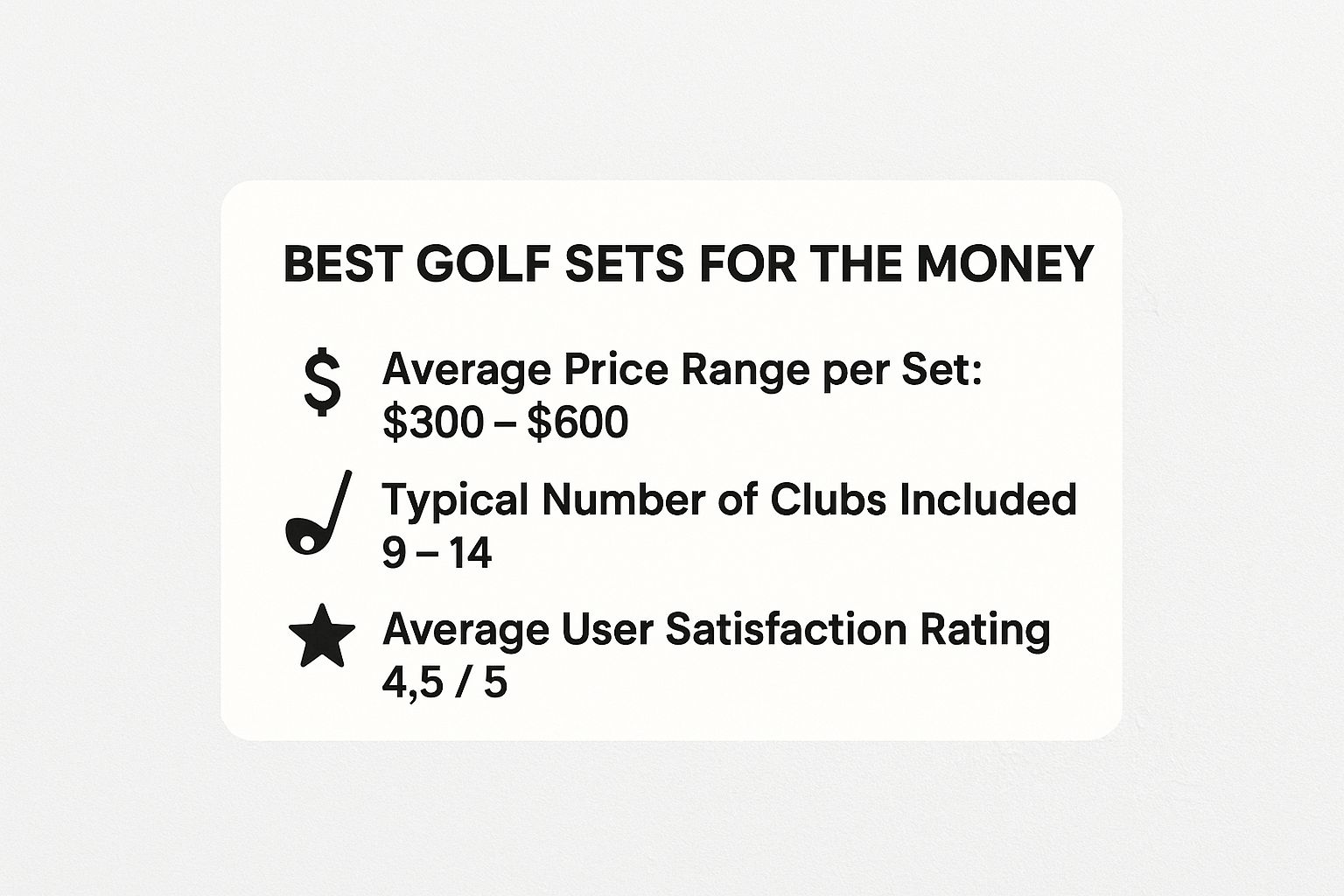
As you can see, spending more usually gets you more clubs and higher satisfaction ratings, but don't overlook the incredible value available in those entry and mid-level sets.
To simplify this even further, here’s a quick-reference table I've put together. It breaks down what you can realistically expect from your investment at different levels.
Golf Set Budget Tiers and What You Get
| Budget Range | Ideal For | Common Materials | Typical Set Composition |
|---|---|---|---|
| $250 - $450 | Absolute Beginners | Stainless Steel & Zinc Alloy | Driver, 1-2 Woods/Hybrids, 4-5 Irons, Putter |
| $450 - $800 | Advancing Beginners | Stainless Steel & Titanium | Driver, 2-3 Woods/Hybrids, 5-6 Irons, Wedges, Putter |
| $800 - $1,200+ | Intermediate Players | Titanium & Tungsten Weighting | Full Set with multiple wedges and hybrid options |
Think of this as your roadmap. Having a clear idea of these tiers will make your search much more focused and help you confidently find a set that truly fits your game and your wallet.
What's Actually in the Bag? A Look at Club Composition and Materials
When you're trying to find a great deal on a golf set, reading the product description can feel like trying to decipher a secret code. But understanding what goes into each club is the single best way to spot genuine value and sidestep sets that are all flash and no substance. It’s not about the number of clubs in the bag; it's about what they're made of and how they’re built to help your game.
Most complete sets will give you a driver, a fairway wood or two, a hybrid, a spread of irons (typically 6-iron to pitching wedge), a sand wedge, and a putter. That’s a solid lineup to get you from the first tee to the final putt. But the smartest sets, especially for beginners and higher-handicap players, make one critical swap.
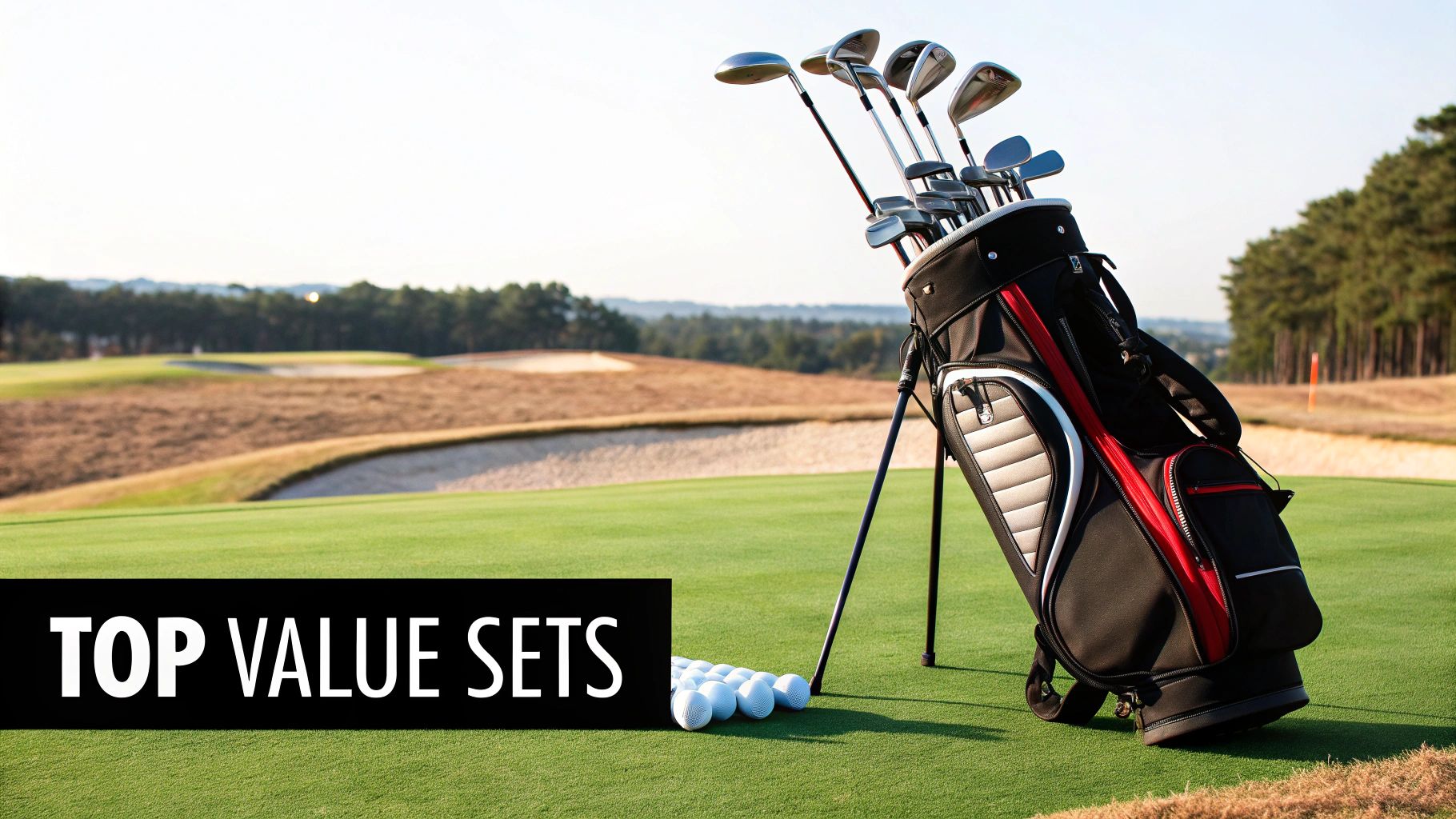
They ditch the hard-to-hit long irons—think 3, 4, and 5-irons—for much more forgiving hybrids. A hybrid is exactly what it sounds like: a cross between a fairway wood and an iron. The design makes it infinitely easier to launch the ball high and straight from almost any lie. If a value-priced set includes at least one hybrid, that’s a huge plus. It shows the company actually gets who they're building the clubs for.
The Materials That Make or Break a Club
Beyond the types of clubs, the materials used have a direct impact on performance, feel, and how long your investment will last. This is most obvious in two key parts of your bag: the driver and the irons.
-
Driver Heads: Here, the big debate is titanium vs. stainless steel. Titanium is the clear winner. It's incredibly light and strong, which lets manufacturers build those huge, forgiving 460cc heads that help you generate more ball speed. It costs more, sure, but the performance jump is so massive that almost any quality set today will feature a titanium driver. A stainless steel driver is a dead giveaway of a bare-bones, ultra-budget set.
-
Iron Heads: For irons, the choice is usually between stainless steel and zinc alloy. Stainless steel is the workhorse of the industry—it's durable, feels solid, and performs consistently. Zinc alloy, on the other hand, is a much cheaper and softer metal found in many rock-bottom starter sets. They'll get the job done for a true beginner, but they dent easily and give you a dull, unsatisfying feel at impact.
My Takeaway: Always check the driver material first. If you see titanium, it's a great sign the manufacturer put money where it matters most. For irons, stainless steel is the way to go for better long-term value and a much more rewarding feel on well-struck shots.
Reading Between the Lines
So, how does this help you shop smarter? When you see “460cc Titanium Driver” on the box, you know you’re getting a modern, forgiving club designed to help you hit it long and straight. That’s a big check in the "pro" column.
On the flip side, if a set proudly includes a 3-iron and 4-iron but no hybrids, pause and think. Are you really going to use those? For most of us, those clubs just gather dust and add frustration. A well-designed set is all about playability. The best value isn't just a low price tag—it's getting a set of clubs that you'll actually enjoy playing and that will help you get better.
Matching Shaft Flex to Your Swing
Think of the club shaft as the engine of your golf club. It’s what transfers all the energy from your body into the ball, yet it’s probably the most overlooked part of a club set, especially when people are hunting for a good deal.
Picking the wrong flex can absolutely wreck your game, no matter how fancy the clubhead is.
A mismatched shaft is a recipe for inconsistency. If the shaft is too stiff for your swing speed, you’ll fight to get the clubface square at impact. The result? A weak slice that robs you of distance. On the flip side, a shaft that’s too flexible will feel whippy and uncontrollable, leading to wild hooks or high, ballooning shots that fall out of the sky.
Finding Your Ideal Flex
So, how do you find the right one? It all comes down to matching the shaft to your unique swing speed and tempo. While a professional fitting is always the best route, you can get surprisingly close on your own.
Here’s a quick guide to the common flex options based on driver swing speed:
- Ladies (L) & Senior (A/M): Perfect for smoother, more deliberate swings, typically under 75 mph. These more flexible shafts help generate extra speed and a higher launch.
- Regular (R): This is the sweet spot for a huge number of male golfers. If your driver swing is somewhere between 75 and 95 mph, this is likely your zone. It’s a great blend of power and control.
- Stiff (S): Built for faster, more aggressive swings from 95 to 110 mph. A stiff shaft offers the stability needed to keep the clubhead under control and prevent the ball from hooking.
A simple on-course test is to just watch your ball flight. If your shots are consistently low and leak to the right (for a righty), your shafts are probably too stiff. If they fly super high and hook hard to the left, they might be too flexible.
Most complete sets designed for value come standard with Regular flex shafts. For the vast majority of new and intermediate golfers, this is a perfectly safe and effective starting point.
To get the most out of any club, making sure your body is ready is key. You can learn more about this in our guide on the top golf mobility exercises for a better swing. It’ll help ensure you can deliver the power your clubs are designed to handle.
How to Research and Test Clubs Before Buying
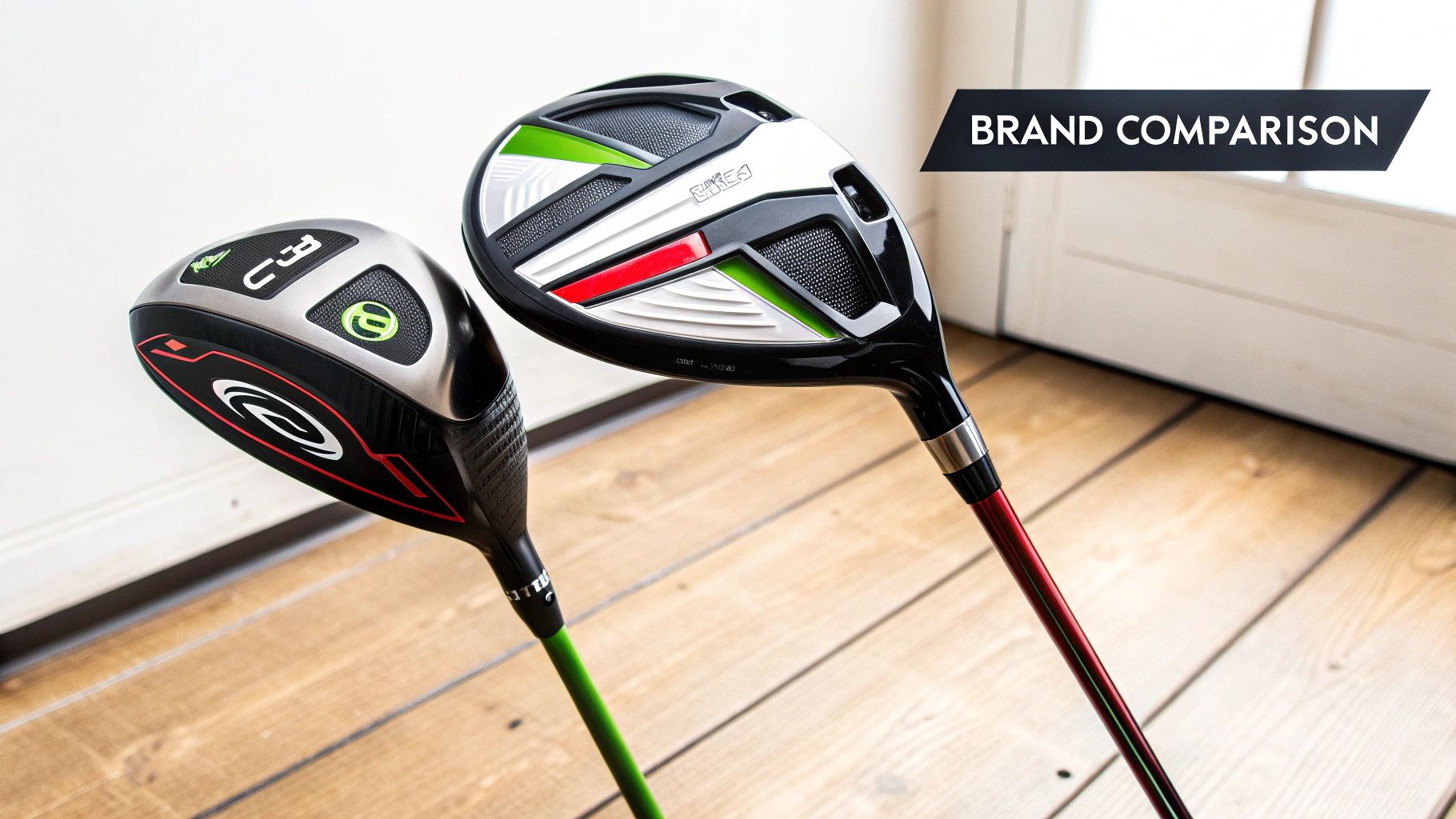
Reading online reviews is a great starting point, but let’s be honest—they can’t tell you how a club will actually feel in your hands. To find the best value, you need to get out there and swing them.
When you're scanning reviews, look for recurring themes. If multiple golfers mention the driver has an odd sound or the grips feel cheap, that’s a red flag. But a single comment about "feel"? That's purely subjective, so don't let one person's opinion sway you too much.
The global golf equipment market is huge, with sales hitting around USD 3.96 billion each year. All that competition means manufacturers are constantly fighting for your dollar, so getting hands-on is the only way to cut through the marketing fluff.
Getting a Feel for the Clubs
You don't need to book an expensive custom fitting just to try a set. There are plenty of practical, low-cost ways to get the feedback you need before pulling out your wallet.
- Hit up a retail store. Most big golf or sporting goods shops have hitting bays and simulators. This is the easiest way to compare a few different models side-by-side.
- Find a demo day. Brands often host free events at local courses where you can test-drive their entire lineup. It's a fantastic opportunity.
- Borrow from a buddy. If a friend plays a set you’re eyeing, ask to hit a few balls with them at the range.
When you swing, don't just stare at the distance numbers on the screen. Pay close attention to the club's weight and balance. Does it feel easy to control? The sound and sensation at impact are also huge clues—a solid, satisfying "thwack" almost always points to better quality than a dull, hollow "clink."
Ultimately, you’re looking for clubs that make you feel confident standing over the ball. For a deeper dive, our guide on how to choose golf clubs for your game has even more specific advice.
Where to Find the Best Deals on Golf Sets
Knowing what clubs to buy is only half the battle. Knowing where to find them is how you save some serious cash. Hunting for the best golf sets for your money means looking past the first Google result and checking out a few different spots, each with its own advantages.
For most people, the search starts at big-box sporting goods stores or one of the major online golf retailers. They have a huge selection, and you can usually test out the clubs right there in a hitting bay. But the real hidden gems? They're often with the direct-to-consumer (DTC) brands that sell exclusively online. By cutting out the retail middleman, they can offer fantastic quality for a much lower price.
Exploring Your Options Online and Offline
Sure, traditional brick-and-mortar stores still move a ton of gear, but online shops are catching up fast. Why? Better pricing and sheer convenience. This has created a great market for golfers where quality, affordable sets that perfectly balance price and performance are easier to find than ever. You can see more data on the golf equipment market on coherentmarketinsights.com.
And whatever you do, don't sleep on the second-hand market. Places like Callaway Pre-Owned or GlobalGolf are absolute goldmines for gently used sets from top-tier brands. You can often snag last year's premium models for what you'd pay for a brand-new beginner set. Just be sure to zoom in on the pictures and check for heavy wear and tear on the clubfaces and grips.
Pro Tip: Timing is everything. The best deals almost always pop up during end-of-season sales in the late fall and winter. Retailers are trying to clear out old inventory to make room for the new models, which means big-time markdowns for you.
Here's another trick: look for "complete" package sets that come with a bag. Buying everything bundled together is almost always cheaper than piecing a set together one club at a time. A good package set will also include a solid bag, which you can easily pair with an electric caddy. Our guide on the top trolleys for golf bags can help you find the perfect one for your new setup.
By combining a few smart shopping strategies—comparing online DTC brands, browsing reputable used sites, and timing your purchase—you can lock in an excellent set of clubs that performs way above its price tag.
Your Top Golf Set Questions, Answered
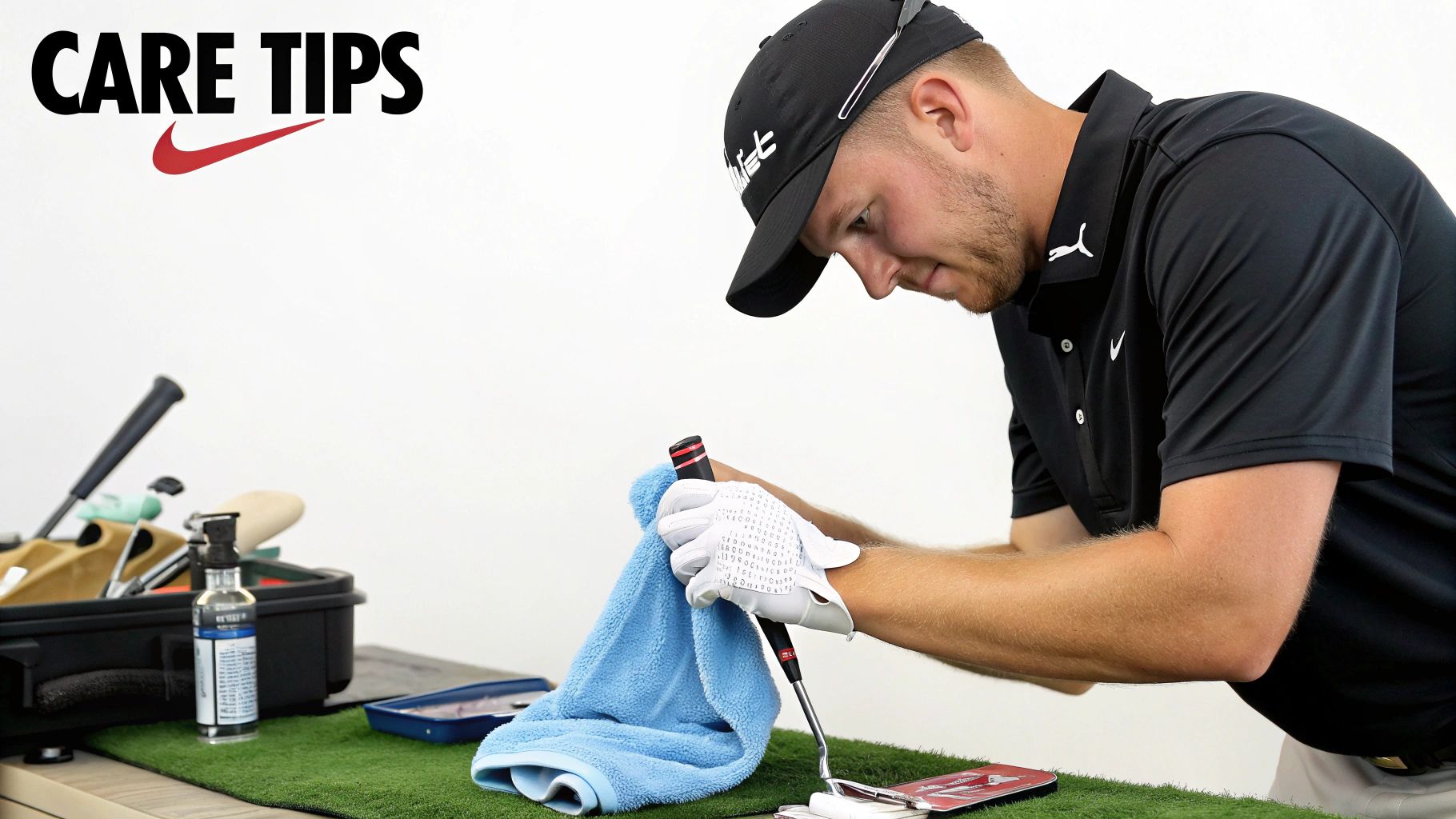
Even after breaking everything down, I know a few questions probably still come to mind. These are the ones I hear all the time from golfers just starting out, so let's clear them up so you can feel confident in your choice.
How Much Should a Beginner Really Spend on Golf Clubs?
For your first set, you'll want to target the $250 to $500 range. This is the sweet spot. You get quality gear that's forgiving enough for a beginner to learn with, but you aren't breaking the bank on a hobby you're just getting into.
The sets in this price bracket usually come with everything you need—from a driver down to a putter and a bag to carry them in. They’re built to last while you hone your skills.
Is it Better to Buy a Complete Set or Build One?
For anyone new to the game, and honestly, for most high-handicappers, a complete, boxed set is the way to go. There’s no guesswork. The clubs are designed to complement each other, giving you consistent gapping and feel throughout the bag. It’s also far, far cheaper than buying each club separately.
Building a set piece by piece is a fantastic option, but it’s really for the more seasoned player who has a deep understanding of their swing, their yardage gaps, and what they specifically need from each club.
Can I Save Money Buying Used Golf Clubs?
Absolutely. Buying used can be a brilliant move, letting you get your hands on premium equipment for a fraction of the original price. With North America's golf club market valued at over USD 3 billion, the second-hand market is huge and full of great deals. You can find more details on the size of the golf equipment market from Research Nester.
Just be sure to check the grips and grooves for excessive wear before you buy!
Once you've found the perfect set, make walking the course effortless with Caddie Wheel. Learn how our electric power assist can upgrade your push cart and help you save energy for your best shots.

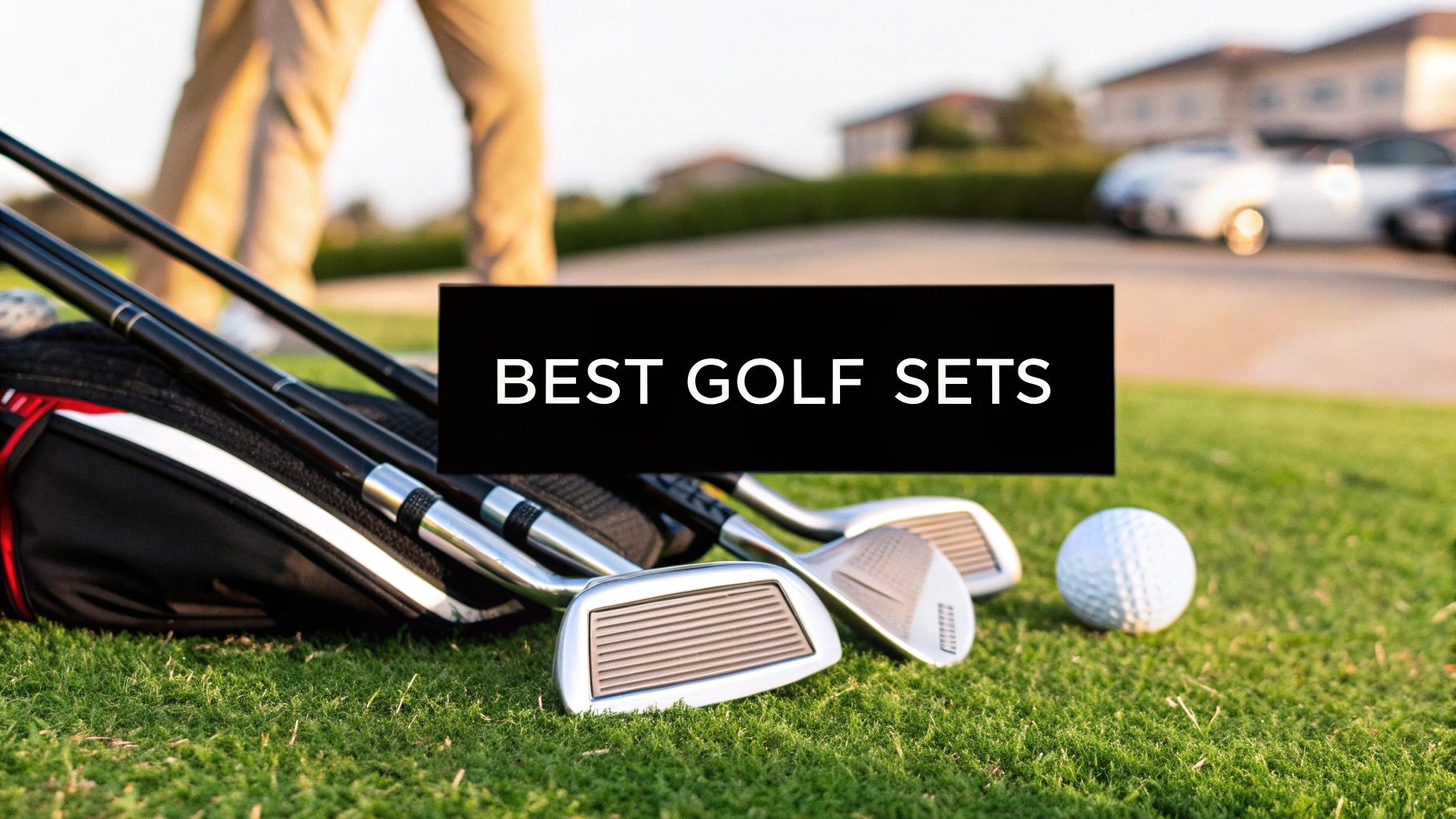
Share:
Your Guide to Motorized Golf Bag Carts
Your Guide to a Battery Cart Golf Powered System